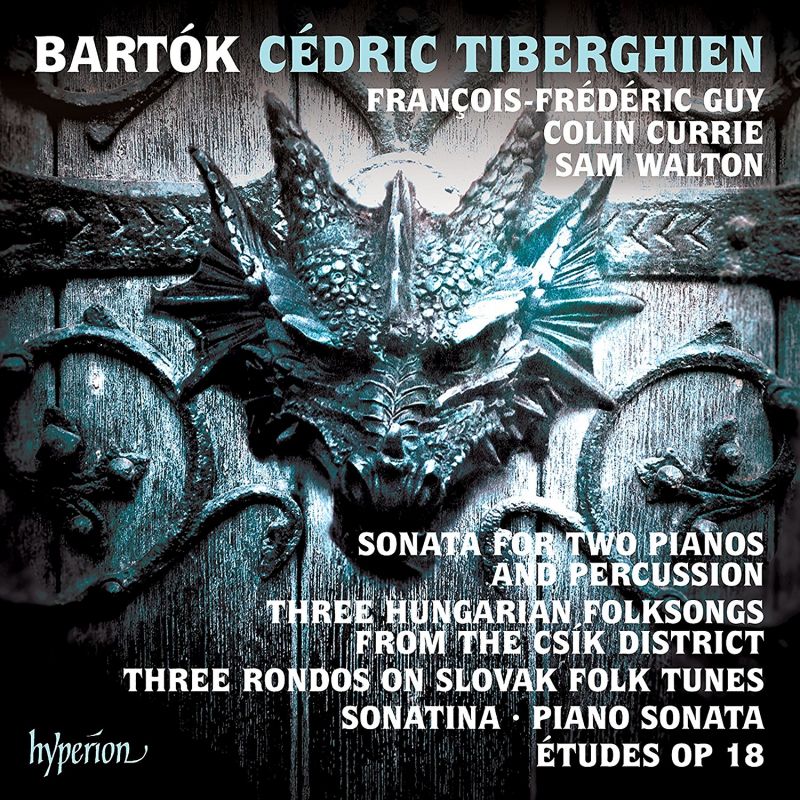BARTÓK Sonata for 2 Pianos and Percussion
View record and artist detailsRecord and Artist Details
Composer or Director: Béla Bartók
Genre:
Chamber
Label: Hyperion
Magazine Review Date: 03/2017
Media Format: CD or Download
Media Runtime: 65
Mastering:
DDD
Catalogue Number: CDA68153

Tracks:
| Composition | Artist Credit |
|---|---|
| Sonata for Piano |
Béla Bartók, Composer
Béla Bartók, Composer Cédric Tiberghien, Piano |
| (3) Hungarian folksongs from the Csík district |
Béla Bartók, Composer
Béla Bartók, Composer Cédric Tiberghien, Piano |
| Sonatina |
Béla Bartók, Composer
Béla Bartók, Composer Cédric Tiberghien, Piano |
| (3) Rondos on (Slovak) Folktunes |
Béla Bartók, Composer
Béla Bartók, Composer Cédric Tiberghien, Piano |
| (3) Studies |
Béla Bartók, Composer
Béla Bartók, Composer Cédric Tiberghien, Piano |
| Sonata for Two Pianos and Percussion |
Béla Bartók, Composer
Béla Bartók, Composer Cédric Tiberghien, Piano Colin Currie, Percussion François-Frédéric Guy, Piano Sam Walton, Percussion |
Author: Rob Cowan
The Three Hungarian Folksongs from the Csík District open very slowly and dreamily. Again you’re often left holding your breath between the fall of one note and the next. At the start of the Sonatina, the rhythm sounds oddly skewed, and even more distorted in the second movement. A longed-for simplicity of approach arrives with the Three Rondos on Slovak Folk Tunes, at least to start with – by the time Tiberghien reaches the vivacissimo he’s up to his old tricks again, though the boogie-style Allegro molto is boldly assertive, with some vividly brushed arpreggios. The first of the Études seems at pains to sidestep any hint of aggression, inappropriately so in my view, given that this is profoundly propulsive music. The more Impressionist Second Étude and the energetically playful Third come off far better, though Zoltán Kocsis takes some beating, and so does Charles Rosen (Sony Classical, 10/64 – nla).
I really want to like this playing more than I actually do, whereas I loved Tiberghien’s freewheeling approach to the Bagatelles and Eight Improvisations on Hungarian Peasant Songs on the previous (second) volume in this series (11/16). Still, all comes right in the end with an admirable performance of the Sonata for two pianos and percussion, where Tiberghien is both goaded and kept in check by fellow pianist François-Frédéric Guy, with sensitive support from the percussionists Colin Currie and Sam Walton. Superb sound sees to it that every kicking syncopation and drum tap is clearly focused. Of the three volumes of Tiberghien playing Bartók I’d say that the second is definitely the one to go for first. See how you get on with that and then proceed accordingly. But if all you require is a compelling, jazzily inflected version of the Sonata for two pianos and percussion, then look no further.
Discover the world's largest classical music catalogue with Presto Music.

Gramophone Digital Club
- Digital Edition
- Digital Archive
- Reviews Database
- Full website access
From £8.75 / month
Subscribe
Gramophone Full Club
- Print Edition
- Digital Edition
- Digital Archive
- Reviews Database
- Full website access
From £11.00 / month
Subscribe
If you are a library, university or other organisation that would be interested in an institutional subscription to Gramophone please click here for further information.




